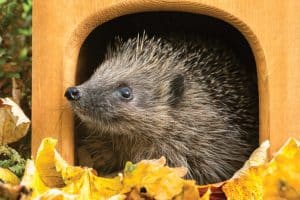Winter is not the time to hide from the world outside, when you can wake up to some of the UK’s wonderful wildlife instead. This winter period in the run up to Christmas conjures images of robins and holly.

Yet living alongside these festive favourites, there are some shy species you might also catch a glimpse of this winter. There’s some great news for those who can’t face the cold – if you take on board these tips, you can watch many of them, in warmth, from your window. It is easy to attract wildlife to your garden in winter – it is mostly about what not to do!
Let it grow
If warmer winters mean your grass keeps on growing, let it! Leave it to provide shelter for insects through the winter months which, in turn, can feed the birds. If you don’t want to leave the entire lawn, adjust your mower to cut the grass to at least 3.5 to 5cm and consider leaving a patch to grow, which can provide a corridor for creatures like frogs and mice.
Leave rotting wood
Rotting wood is a valuable part of the ecosystem, and if you don’t clear it away, could become home to beetles, fungi, centipedes and more.
Don’t burn or discard all the dead leaves in your garden
Some creatures use dry leaves to line their nests or burrows. If you make a pile in the corner of your garden, something is bound to move in. The mulch left over from dead leaves is full of nutrients, good for worms and other mini-beasts.
Don’t cut back your Ivy
The flowers can provide nectar to insects like queen wasps through the winter months and it offers a safe winter hideaway for butterflies and small mammals. The berries will ripen through winter and provide food for birds.
Alternatively, you can help insects through the winter by placing wooden boxes with hollows or bamboo that will provide a snug spot to see out the frosts and cold weather.
Don’t cut back hedges when they are producing berries
All sorts of berries are a valuable food source for birds and mammals.
Rockin’ Robin
Top of the list for iconic Christmas species, the hardy robin is not perturbed by the icy touch of a winter day, and is frequently a gardener’s willing companion.
Robins are nothing if not resourceful, and will sit waiting for a pitchfork to unearth a tasty earthworm. In December your garden could become a speed-dating hotspot for robins, as this is when they tend to pair up.
Hedge fruits are an important food source for robins, so having some brambles on the go is a good way to keep your garden robin-friendly.
If you want to be a real favourite with Mr Redbreast though, leave a dish of mealworms outside for them. Of course, they also favour the seasonal classic, a piece of juicy Christmas cake!
Tit’s the season to be jolly
When winter hits, food becomes scarce for most animals. The ground is frozen, creatures have settled down to conserve energy, and foliage has been shed. You can provide a real helping hand by leaving out food for hungry mouths and, in turn, you will be rewarded with some great garden companions.
Blue tits and great tits can often be seen in gardens where hanging feeders full of seed have been left out. Thrushes prefer to fill up on bread and fat and finches love niger seed and wild flower patches.
Frosty fluttering
If you see a flash of red in your garden at Christmas time, don’t assume it’s a robin – you might have a more unusual visitor in the shape of a red admiral butterfly. Red admirals often over winter in garden sheds, but may become active again on warmer days.
You can make your garden more butterfly-friendly in winter by laying down some winter-flowering plants such as honeysuckle (Lonicera fragrantissima) and jasmine (Jasminum nudiflorum). Butterflies use up valuable energy reserves by being active in winter so if you see any, leave out a dish of sugar water to give them a boost.
Russet roaming
December and January is mating season for the fox, so you are much more likely to spot them prowling at this time of year. If you have any scraps of food in your garden they are likely to come scavenging, and they are not fussy, eating anything from apple peel to bird food! It can be easier to see foxes in winter because there is less foliage, and if it has been snowing their russet coats make a striking contrast with the ghostly white surroundings.
Scarlet sustenance
Holly livens up the winter landscape with its vivid berries. There are many varieties, and it is worth planting some if you want to attract redwings and blackbirds to your garden. The beds of leaves at the foot of a holly bush also make a lovely warm bed for hibernating species like hedgehogs.
Gardens provide a vital source of shelter and food for wildlife, especially in winter when many species need warm, dry spaces to bed down in. You can help out by holding back on some of your gardening projects, and you will be rewarded with visits from some wonderful species, as well as the knowledge you are making a positive contribution to wildlife and the environment.
Some bird species come to the UK especially for winter, including fieldfare and redwing. These birds come to the UK from Scandinavia and mainly move in flocks. They do not frequent gardens that often, but love hawthorn hedges, and can turn one from a quiet shrub into a seething, twittering hive of activity.
Woodland can be a particular draw for these birds, so why not get out to your nearest wooded (provided you are not under COVID restrictions) and have a look at a lively flock, sure to brighten up a winter’s day.
(Article source: 50 Connect)

